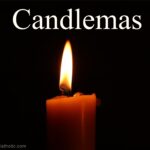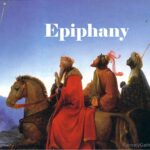
Joseph and Mary presented Jesus at the Temple in Jerusalem to fulfill the Law of Moses which required that the first-born male child be offered to God as a way of giving thanks for sparing the Israelites during the Passover in Egypt.
It was at the Presentation at the Temple that the baby Jesus was recognized as the long-awaited savior by two prophets, Simeon and Anna.
At the same time of the presentation, which took place forty days after the birth of the child, the mother of the child would be purified when the sacrifice of a lamb was offered.
The Blessed Virgin Mary did not require purification but observed the law as Jesus would later. Instead of a lamb, she offers a pair of turtledoves or two young pigeons, which reveals her family’s poverty.
Forty days after Christmas, on February 2, the Catholic Church celebrates the Feast of the Presentation of Lord. It is also known as Candlemas or formerly as the Feast of the Purification of the Virgin Mary.
Candles that are used during Mass, while administering the sacraments, and in other liturgical celebrations are blessed at this time. Candles represent Christ who is the Light of the World.
Saint John Paul II instituted a special day of prayer, World Day for Consecrated Life, and attached it to the Feast of the Presentation of the Lord. This is to honor those consecrated men and women who reflect the light of Jesus upon the world through his Church.
Catholics meditate on the events of the Presentation of Jesus in the Temple as the 4th Joyful Mystery of the Rosary.
The true lamb of God enters the temple:
Ready to greet the Jesus when He comes:
When the days were completed for their purification according to the law of Moses, they took Him up to Jerusalem to present Him to the Lord, just as it is written in the law of the Lord, “Every male that opens the womb shall be consecrated to the Lord,” and to offer the sacrifice of “a pair of turtledoves or two young pigeons,” in accordance with the dictate in the law of the Lord. Now there was a man in Jerusalem whose name was Simeon. This man was righteous and devout, awaiting the consolation of Israel, and the holy Spirit was upon him. It had been revealed to him by the holy Spirit that he should not see death before he had seen the Messiah of the Lord. He came in the Spirit into the temple; and when the parents brought in the child Jesus to perform the custom of the law in regard to Him, he took Him into his arms and blessed God, saying: “Now, Master, you may let your servant go in peace, according to your word, for my eyes have seen your salvation, which you prepared in sight of all the peoples, a light for revelation to the Gentiles, and glory for your people Israel.”
Luke 2: 22-32
Commemorating the Presentation at the Temple of Jerusalem:
Mary and Joseph were obedient to the Jewish Law:
Presenting the Lord in a place of sacrifice:
Anticipating salvation and sorrow:
The presentation of Jesus in the temple shows him to be the firstborn Son who belongs to the Lord. With Simeon and Anna, all Israel awaits its encounter with the Savior-the name given to this event in the Byzantine tradition. Jesus is recognized as the long-expected Messiah, the “light to the nations” and the “glory of Israel”, but also “a sign that is spoken against”. The sword of sorrow predicted for Mary announces Christ’s perfect and unique oblation on the cross that will impart the salvation God had “prepared in the presence of all peoples”.
Catechism of the Catholic Church 529
A great theme of light:
Candles are an important part of the Christian faith:
In the temple of Jerusalem, according to the Gospel account, Simeon, an elderly man of God, takes Jesus in his arms and recognizes that in him salvation has come for Israel and for all peoples: the Light of the Gentiles. The words of the holy old man express the longing that pervades human history. They express that waiting for God, that universal desire, unconscious perhaps, but ineffaceable, that he would come to meet us so that we might be able to share in his life. Simeon embodies the image of humanity striving to grasp that ray of light which renews all things, the seed of life that transforms all old age into everlasting youth.
Pope John Paul II, Angelus Address, 2 February 1997
Mary did not need purification:
A day of special prayer for men and women in consecrated life:
The Truth, Goodness, and Beauty of the Catholic Church
Ask questions:
Share this page with friends and family to start a conversation about your faith.
Don’t miss a post. Learn more about the Catholic Church and strengthen your Catholic faith.
Find more Fiercely Catholic video issues here.
Subscribe here.


